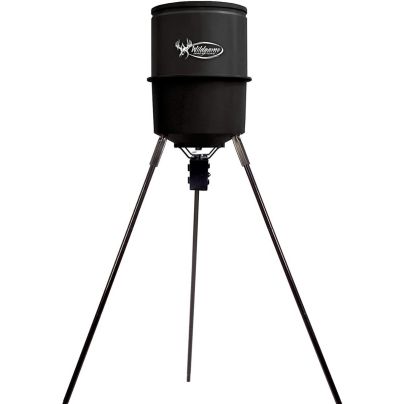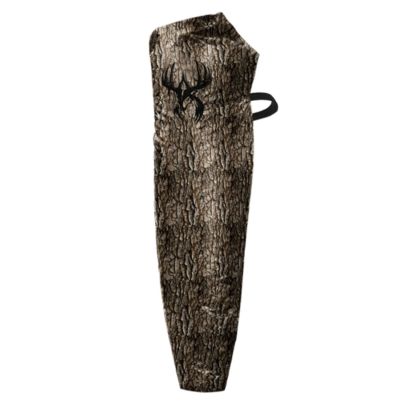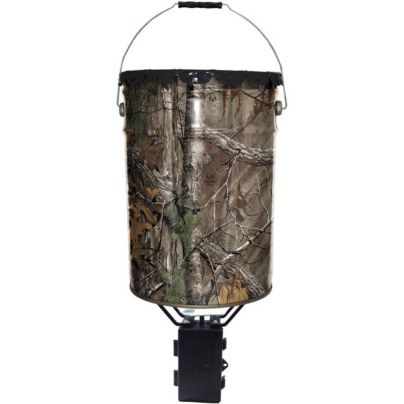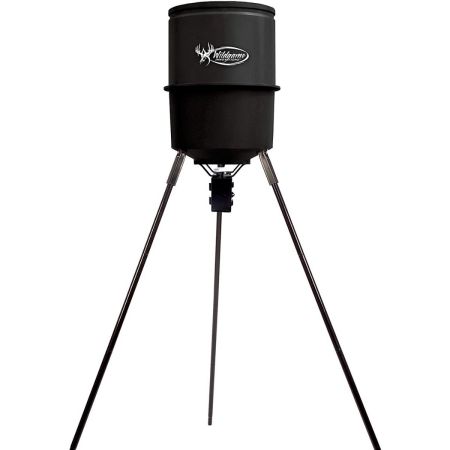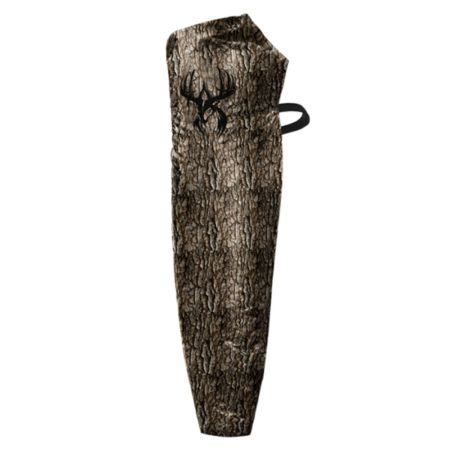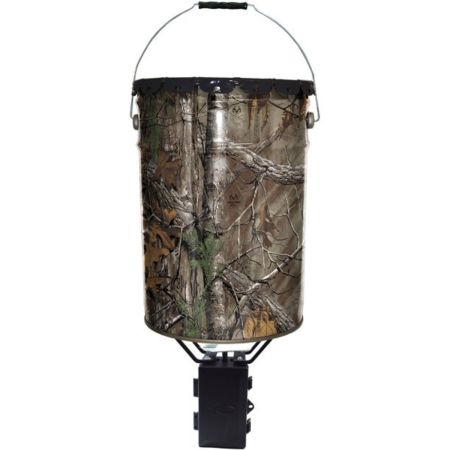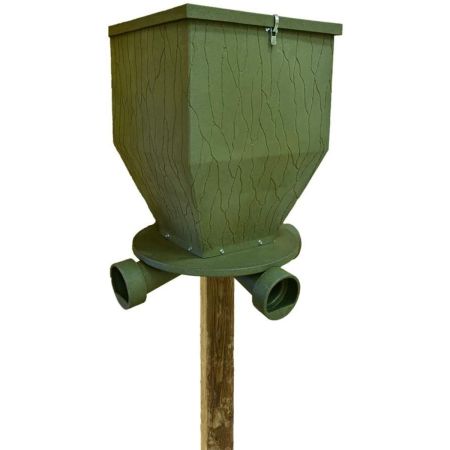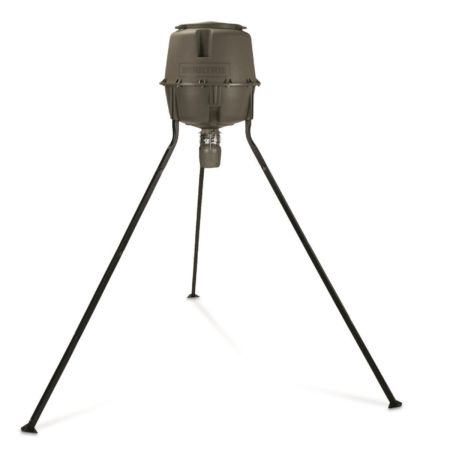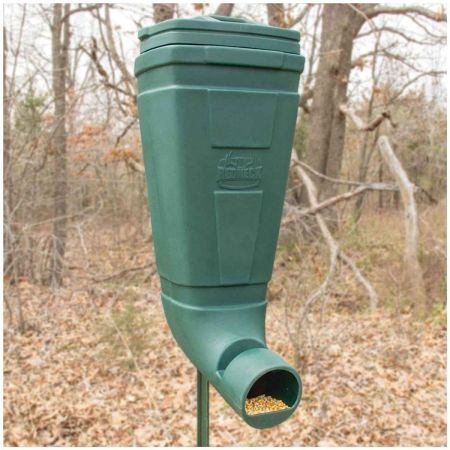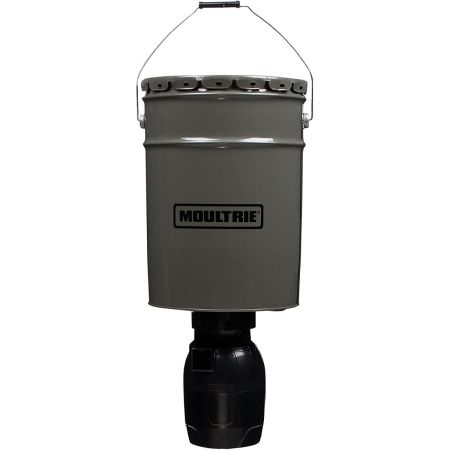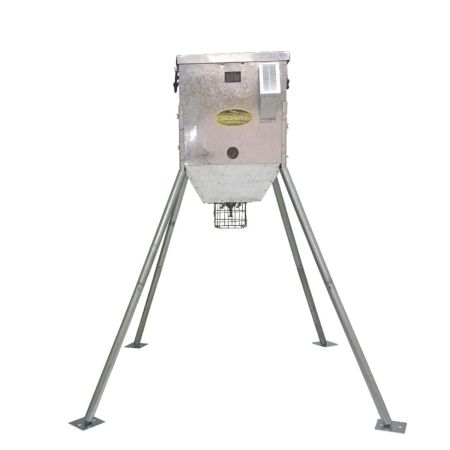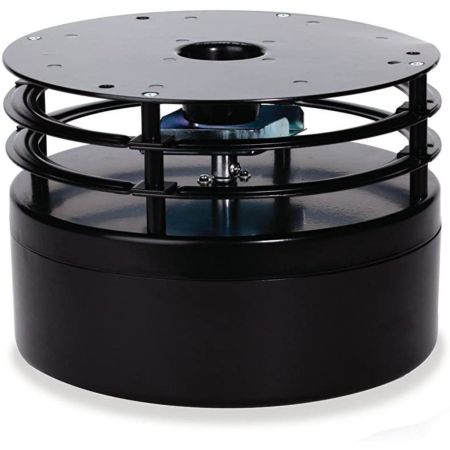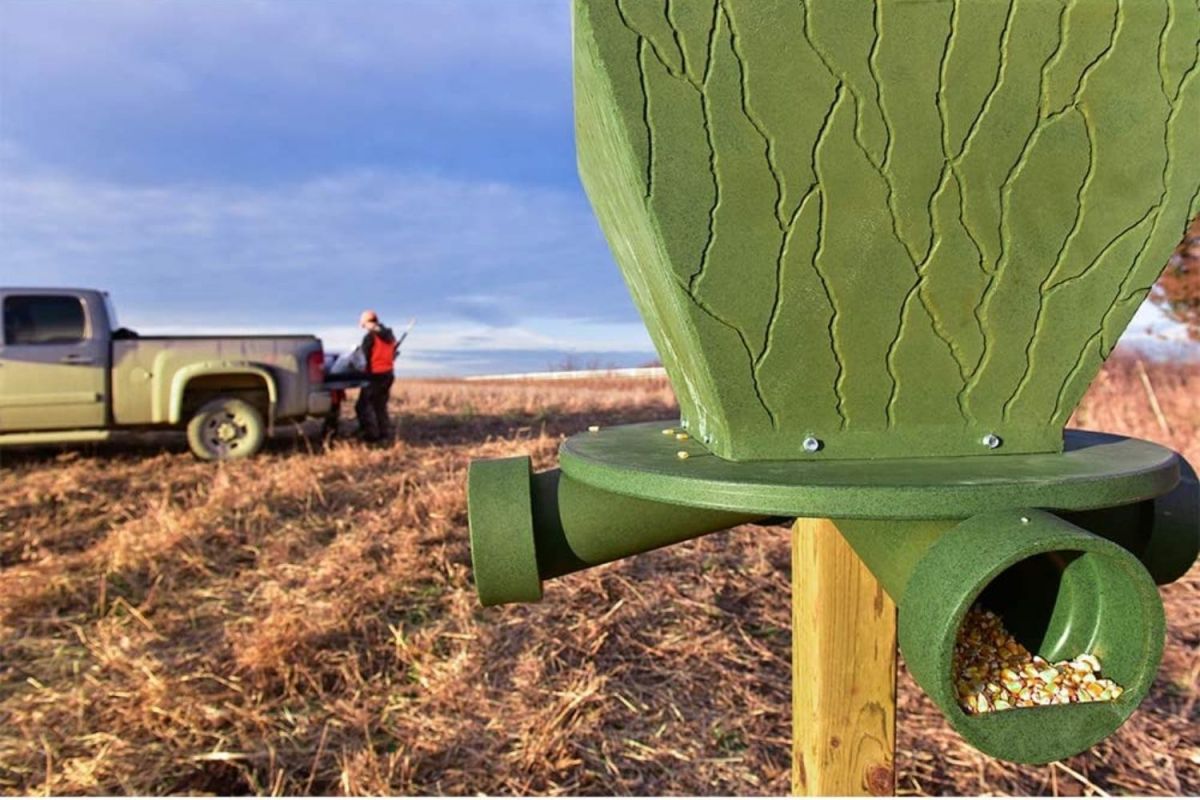
We may earn revenue from the products available on this page and participate in affiliate programs. Learn More ›
Deer feeders allow hunters as well as those who enjoy photographing or watching deer to attract these beautiful, wild creatures to specific locations. When appropriately nutritious food is offered during the winter months, deer feeding can contribute to the health of deer populations.
Shoppers may find an array of deer feeders on today’s market, featuring numerous options for installation and operation. With choices ranging from high-tech programmable models to low-tech setups, the best deer feeders suit the needs of humans and deer alike.
- BEST OVERALL: Wildgame Innovations Tri-Pod Deer Feeder
- BEST BANG FOR THE BUCK: Wildgame Innovations TREEHUGGER Gravity DeerFeeder
- BEST HANGING FEEDER: Wildgame Innovations Pail Feeder
- BEST POST-MOUNTED FEEDER: Banks Outdoors Gravity Fed Deer and Game Feeders
- BEST TRIPOD FEEDER: Moultrie Unlimited Tripod Deer Feeder
- BEST GRAVITY FEEDER: REDNEK Redneck Outdoors T-Post Gravity Feeder
- BEST AUTOMATIC FEEDER: Moultrie Directional Hanging Feeder, 30-Degree Range
- BEST SPINNING FEEDER: SpinTech 300LB Galvanized Corn Feeder
- BEST PROGRAMMABLE KIT: Moultrie Pro Magnum Deer Feeder Kit
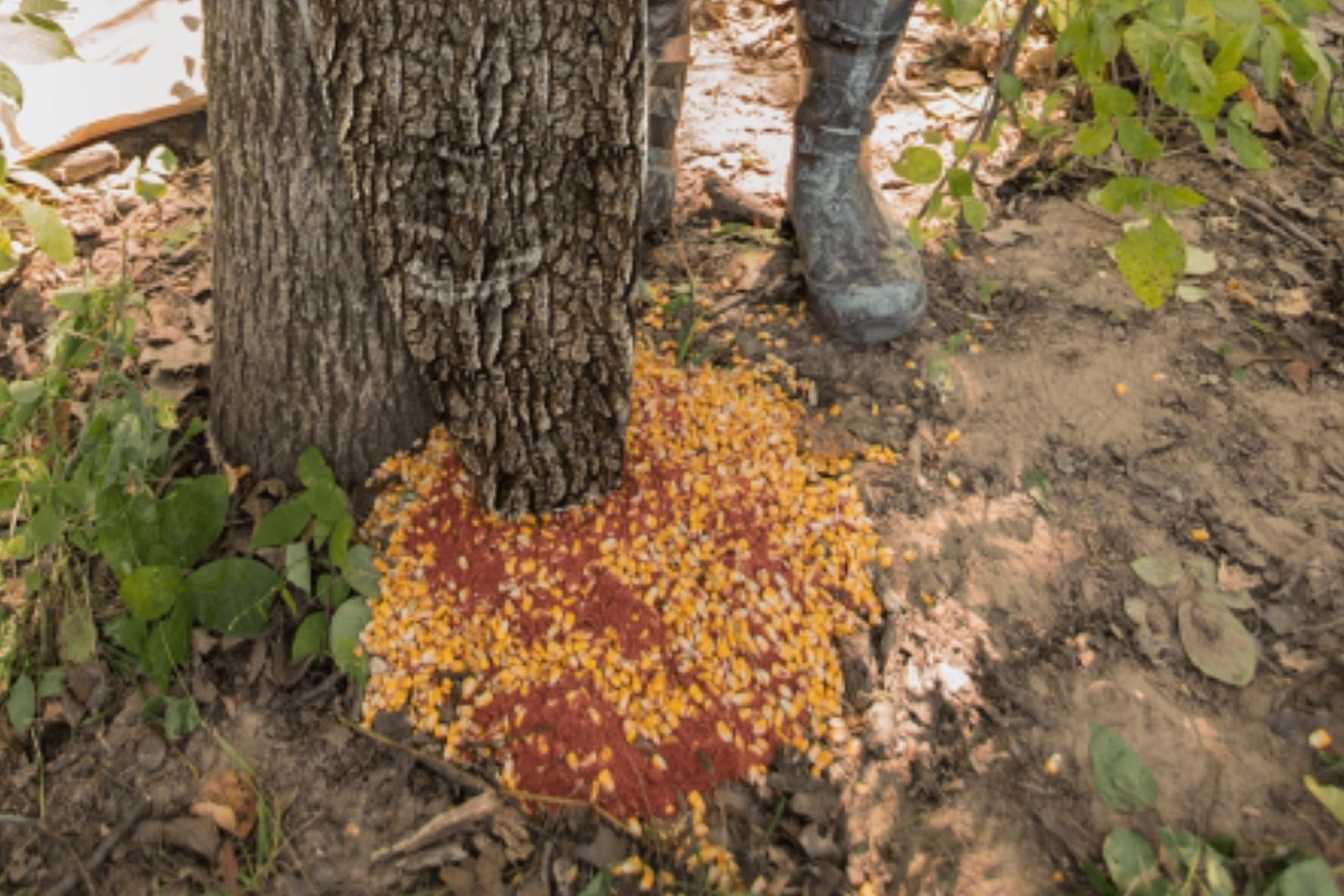
What to Consider When Choosing the Best Deer Feeders
Deer feeders are available in a wide array of sizes, capacities, and designs, and they’re sold at a variety of price points. To make an optimal selection, shoppers may consider materials, durability, ease of use, and other factors. Whether searching for a high-tech programmable feeder or a simple gravity-operated alternative, shoppers may find numerous viable options. Read on to discover the key considerations for choosing the best deer feeder.
Local Laws
Each state establishes regulations for feeding deer and other wildlife. Before setting up a deer feeder, it’s a good idea to check individual state and local laws. Search the websites for state governments, game and wildlife departments, or departments of natural resources to find the necessary information about feeding deer in compliance with the law.
In many cases, it is legal to feed deer on private property, but state laws vary regarding the legality of baiting deer for hunting. Some states outlaw the practice of hunting deer in areas where food is offered. However, hunting may resume 30 days after the food has been removed from a previously baited area.
There is no widespread consistency regarding the feeding of deer from one state to another or from one locality to another. For this reason, individuals should research their local laws before setting up deer feeders.
Types of Deer Feeders
Deer feeders vary from high-tech programmable options to simple gravity-operated models. Four-legged or tripod designs feature hoppers set atop adjustable metal legs. Other feeders may be mounted on posts, fencing T-posts, or trees. Additionally, some deer feeders are designed to hang from hooks, tree limbs, or cables strung between trees.
Many feeders offer programmable digital timers that activate battery-powered motors to broadcast feed via spinning plates at specific times of the day and for preset durations. The automatic feeders provide convenience and control for users.
On the other hand, the simple gravity-operated feeders get the job done without batteries or technology. The downside of nonautomatic feeders is that the user does not control the feeding times or the amounts of feed consumed by deer and other wildlife.
Location
Deer feeders should always be located on private property in areas where state and local laws allow their use. Those individuals who choose to feed deer may search for the optimal locations to place feeders so that the deer are attracted to the food sources. In general, deer will feed in open areas at dawn and dusk. Additionally, they may feed at other times of day in sheltered areas with coverage from trees and undergrowth.
Experts recommend exploring the property, looking for deer trails and finding the deer’s favorite places for bedding and drinking fresh water. Then, users may place deer feeders near those familiar locations where the deer feel safe.
Material and Durability
To be useful, a deer feeder must keep the corn and pellets dry to avoid growth of bacteria and mold. For this reason, weather-resistant and waterproof materials are desirable. Metal, galvanized steel, thick polyethylene plastic, and PVC vinyl are viable choices for their durability and weatherproofing.
Users want to keep critters such as raccoons and squirrels out of the deer feeders. Metal materials prevent animals from chewing through the walls of hoppers to get to the deer feed. Galvanized steel is particularly strong and long lasting. Additionally, many automatic feeders feature varmint guards that resemble metal-mesh cages surrounding the spinners and mechanical parts.
Capacity
Depending on the size of the area and the deer population, users may want to offer more or less food in their deer feeders. The basic design of all types of feeders includes a hopper or a contained area into which users load the corn and food pellets. With varying sizes and types, the capacities of these hoppers vary among diverse feeders. Some models hold as little as 50 pounds of feed while others boast a capacity of 300 pounds or more.
When selecting appropriate deer feeders, shoppers may consider their individual needs. On small properties where wildlife lovers want to attract a few deer to backyard locations, small deer feeders with limited capacities will suffice. Alternatively, a hunter with access to extensive acreage and a large deer population may opt for a feeder with a large capacity.
Easy Installation
When it comes to installation, deer feeders vary in their complexity. Some feeders simply attach to a tree via straps, while others require mounting on poles or hanging from cables with a pulley system for refilling. Tripod feeders and those that stand on four legs offer somewhat easy installation procedures. These include finding level ground for installation and staking the feet down for extra stability.
Pole-mounting a feeder requires supplying a post or fencing T-post, bolts, and mounting hardware or straps to install the feeder. Additionally, the pole or post should be buried 3 feet in the ground and set in cement.
Hanging feeders require ropes or cables to suspend them from tree limbs. Simple pulley systems facilitate lowering the feeders for cleaning and refilling.
Easy to Use
Experts recommend that users not visit their deer feeders on a daily basis. When humans stay away, the deer are more likely to feel comfortable enough to approach and eat from the feeder. For this reason, easy-to-use feeders help the deer as well as the humans.
For ease in refilling, the lids of hoppers should be about 5 to 5½ feet off the ground. A hanging deer feeder suspended at a greater height may be installed with a pulley system to lower it when it’s time to refill. Additionally, feeders with large hoppers require less frequent refilling.
Automatic deer feeders offer convenience and ease of use. Digital timers allow users to set the times of day and the durations for dispensing feed. Large buttons and LCD screens with large numbers facilitate setting the timers.
Battery Life
Most automatic deer feeders require rechargeable 6-volt batteries, although some use two 6-volt batteries or require 12-volt options. As a general rule, a 6-volt battery in a deer feeder will last 4 to 6 weeks, but battery life varies according to use.
Much depends on the frequency and duration of the programmed feeding times. Many automatic feeders allow users to program up to six daily feeding times. These may be preset for durations ranging from 1 to 20 seconds. With more frequent feedings of longer duration, the battery will see more use.
Some automatic deer feeders feature solar panels to recharge their batteries. In some cases, the solar panel mounting is provided, but the panel must be purchased separately.
Weather Resistance
Deer feeders remain outdoors year-round in all weather and climate circumstances. As deer feeding is frequently a wintertime activity, the feeders must be able to operate in harsh conditions, including rain, snow, wind, and ice.
Waterproof materials such as polyethylene plastic, PVC vinyl, metal, and galvanized steel make useful, weather-resistant exteriors for deer feeders. Additionally, the lids for hoppers must fit tightly and have locking mechanisms to keep moisture out of the feed.
Automatic deer feeders have mechanical parts, including digital timers, motors, and spinners. Weather-resistant feeders provide metal housings for these parts to protect them from rain and harsh weather conditions.
Varmint Proofing
Nobody sends engraved invitations for the deer to eat from deer feeders while telling the other animals to stay away. Raccoons, squirrels, rats, mice, and (in some locations) bears are among the varmints that will be attracted to a deer feeder.
Heavy-duty materials like sturdy and thick plastic, metal, and galvanized steel will keep varmints out of feeders. Additionally, tight-fitting hopper lids with locking mechanisms will help to keep critters from breaking into the feed supply. Some automatic feeders feature varmint guards consisting of metal-mesh cages that enclose the spinners and mechanical parts.
Greasing the legs of tripod feeders will help to keep raccoons and other critters from climbing up to the hoppers. Alternatively, feeders may be suspended from cables strung between trees to keep them away from unwelcome guests.
Our Top Picks
Offering a range of designs, sizes, and convenient features, this collection of top picks includes some of the most advantageous choices in deer feeders on today’s market. Ahead, discover viable options from reputable manufacturers.
Best Overall
Wildgame Innovations Tri-Pod Deer Feeder
This weather-resistant tripod deer feeder from Wildgame Innovations is easy to set up and ready to begin operation in about 15 minutes. Weighing in at 37 pounds, it’s not difficult to manage, yet it holds 30 gallons (225 pounds) of feed.
Set the timer for up to four daily feeding times, and select a duration of 5, 10, 15, or 20 seconds, depending on how much feed is needed. The digital power control unit operates on a 6-volt battery (not included).
Use corn or protein pellets in the durable poly barrel. A built-in funnel disperses the feed accurately. The spinner plate that broadcasts the feed is fashioned from galvanized steel, and the three legs are made of heavy-duty coated metal.
Product Specs
- Dimensions: 24 by 23 by 18 inches
- Hopper capacity: 30 gallons or 225 pounds
- Material: Alloy steel
Pros
- Digital timer
- Selection of feed-dispensing durations
- Easy setup
- Galvanized steel spinner
Cons
- The legs may need reinforcement for sturdy support
- May take longer than 15 minutes to set up the first time
Best Bang for the Buck
Wildgame Innovations TREEHUGGER Gravity Deer Feeder
For wildlife lovers on a budget, here’s a simple, no-frills, low-maintenance deer feeder from Wildgame Innovations. The Treehugger attaches to a tree with the included straps and heavy-duty buckle.
Working with gravity, the deer feed descends and discharges from the bottom, replenishing naturally as deer consume the feed. There’s no need for tools, batteries, or digital settings.
Easily move this deer feeder from one location to another. It weighs only 5 pounds, yet it holds 100 pounds of feed. It’s fabricated from a flexible and weatherproof vinyl (PVC) plastic material, and the roll-top sealed closure protects the deer feed from rain. Its lightweight, portable design allows users to take this deer feeder into remote, hard-to-reach locations.
Product Specs
- Dimensions: 13 by 12 by 2 inches
- Hopper capacity: 100 pounds
- Material: Flexible and weatherproof PVC
Pros
- Lightweight
- Portable
- No batteries required
Cons
- No digital timer to set feeding times
- Does not broadcast the feed
- Varmints can access the deer feed
Best Hanging Feeder
Wildgame Innovations Pail Feeder
The pail design of this deer feeder facilitates quick setup and portability. Hang it from a tree branch, and it will distribute feed up to 30 feet. Set the timer for feeding at dawn and dusk when deer are most likely to be searching for food.
The durable metal pail features a realistic camouflage design and coloring on its exterior, so it blends with the woodland environment. It holds 6.5 gallons (50 pounds) of deer feed, and the galvanized steel spinner broadcasts the feed. A 6-volt battery operates the simple timer and spinner.
This hanging deer feeder is on the small side, but its compact size and simplicity make it easy to carry from one outdoor location to another. Move the feeder around to discover the location that the deer like best.
Product Specs
- Dimensions: 16.8 by 12.7 by 12.2 inches
- Hopper capacity: 6.5 gallons or 50 pounds
- Material: Alloy steel
Pros
- Quick setup
- Galvanized steel spinner plate
- Exterior camouflage design and coloring
Cons
- Needs rope or cable and hanging apparatus
- Does not set up on legs
- Cannot be programmed for specific feeding times, only dawn and dusk
Best Post-Mounted Feeder
Banks Outdoors Gravity Fed Deer and Game Feeders
Create an optimal feeding situation for adult deer by mounting this gravity feeder from Banks Outdoors on a post at about 4 to 5 feet off the ground. The design of the feeder set on a single post does not interfere with bucks’ antlers as tripod feeders sometimes do.
Made from thick and durable polyethylene plastic, the green feeder blends in with outdoor foliage. It’s also weathertight to keep deer feed dry. The hopper holds 150 pounds of corn or protein feed for deer, and it loads from the top. With a secure lid and locking mechanism, this feeder is also raccoon-proof.
Gravity allows the feed to descend into the feeding ports, so there’s no need for batteries, timers, or digital programming. Users can manage the flow of feed by adjusting the ports, allowing more or less feed to discharge from the hopper.
Product Specs
- Dimensions: 22 by 21 by 13 inches
- Hopper capacity: 150 pounds
- Material: Polyethylene plastic
Pros
- No batteries needed
- Friendly design accommodates bucks’ antlers
- Weathertight
- Adjustable feed ports to manage flow
Cons
- Must be installed on a post (not included)
- Does not feature a digital timer
- Does not feature a spinner to broadcast the feed
Best Tripod Feeder
Moultrie Unlimited Tripod Deer Feeder
This programmable tripod feeder from Moultrie dispenses feed for 1- to 20-second intervals up to six times per day. The EasySet digital timer facilitates programming.
With the tripod design of this feeder, users don’t need to drive a post into the ground or search for a tree limb at just the right height. Set up the feeder legs and adjust them to the desired length from 5½ feet to 8 feet. Then, use the Quick-Lock system to attach the 30-gallon hopper.
The feeder operates on a 6-volt battery (not included) to broadcast feed via a spinner. The BackSpin technology automatically reverses the spin whenever the feeder senses a clog. Additionally, users can adjust the funnel to modify the flow for different types of feed or pellets.
Product Specs
- Dimensions: Tripod legs adjustable from 5½ feet to 8 feet
- Hopper capacity: 30 gallons
- Material: Synthetic
Pros
- Programmable feed times up to six times per day
- Set feed dispensing duration from 1 to 20 seconds
- Spinner broadcasts the feed
- Adjustable-length legs
Cons
- Requires 6-volt battery (not included)
Best Gravity Feeder
REDNEK Redneck Outdoors T-Post Gravity Feeder
This deer feeder from REDNEK uses gravity to feed the deer from a single 4-inch by 5-inch feeding port. The hopper holds 80 pounds of feed and features a secure lid that’s easy to remove for filling from the top.
Mount this feeder on a fencing T-post (not included), using the V-groove on the back. Hardware and mounting bolts are included. Alternatively, it attaches to a tree via the concave back and has grooves for ratchet straps (not included).
The durable polyethylene hopper is weather resistant. Its height from the top of the hopper to the bottom of the feeding tube is adjustable from 34 inches to 60 inches.
Product Specs
- Dimensions: 35 by 17 by 15 inches
- Hopper capacity: 80 pounds
- Material: Polyethylene plastic
Pros
- Includes V-groove, bolts, and hardware for T-post mounting
- Does not require batteries
- No mechanical parts
- Weather-resistant construction
Cons
- T-post not included
- Not programmable
- Does not broadcast the feed
Best Automatic Feeder
Moultrie Directional Hanging Feeder, 30-Degree Range
The simple design of this automatic feeder from Moultrie allows users to hang it by the handle on a hook or a tree limb. It’s portable and easy to set up and program for feeding times and durations.
Program the timer for up to six feedings per day. Select the duration for dispensing food, choosing an interval from 1 to 20 seconds. A spinner broadcasts the feed, and the anti-clog technology makes automatic adjustments for different types of feed.
The bucket and lid are made from metal, and the spinner and housing are plastic. Powered by a 6-volt battery (not included), the spinner casts feed in a narrow 30-degree path. This pattern facilitates attracting deer along a trail or into a food plot.
Product Specs
- Dimensions: 12.2 by 12.2 by 17.2 inches
- Hopper capacity: 6.5 gallons (15-gallon option available)
- Material: Metal bucket and lid with plastic spinner plate
Pros
- Automatic, programmable feeding times
- Programmable feed-dispensing durations
- Automatic adjustments to prevent clogs
- Durable materials
Cons
- Requires a 6-volt battery (not included)
Best Spinning Feeder
SpinTech 300LB Galvanized Corn Feeder
The patented SpinTech spinner in this deer feeder automatically closes and locks when the three-speed motor is off. Both the motor and the digital timer are enclosed within the heavy-duty, galvanized steel hopper to protect the mechanical parts from the weather. The spinner not only rotates but also moves up and down to cast feed and to prevent clogs.
SpinTech includes a rechargeable 12-volt battery along with a solar panel and a panel-mounting site. For programming ease, the digital timer features a large screen and buttons. Set the timer to dispense the feed, selecting from one to eight times per day. The feed dispensing intervals may be set from 1 to 30 seconds per feeding.
The hopper holds an ample 300 pounds of feed, and its lid is 68 inches from the ground, allowing users to refill it without a ladder. Sight glass windows in the side of the hopper allow for viewing the feed level inside the hopper. Rest assured that the hopper stands securely on four heavy-duty galvanized legs with foot pads.
Product Specs
- Dimensions: Lid is 68 inches high
- Hopper capacity: 300 pounds
- Material: Galvanized metal
Pros
- Automatic technology
- Digital timer
- Galvanized steel construction
- Included battery and solar panel
Cons
- Requires battery (included)
Best Programmable Kit
Moultrie Pro Magnum Deer Feeder Kit
This deluxe deer-feeder kit from Moultrie includes durable, high-quality moving parts and technology to outfit an automatic deer feeder. With an all-metal housing, a metal spinner plate, and a built-in varmint guard, the kit is built to last.
The digital timer allows users to program feeding times up to six times per day, and the spinner broadcasts feed for programmed intervals from 1 to 20 seconds. The large LCD screen makes it easy to set the times and durations for dispensing food.
Use a 6-volt battery (not included) or two 6-volt batteries for extended life. For optimal convenience, the kit includes a built-in feed-level indicator, an external power port, and solar panel connectors. An optional solar panel is sold separately.
Product Specs
- Dimensions: 10.25 by 10.25 by 11 inches
- Hopper capacity: None; kit does not include a hopper
- Material: Metal
Pros
- Programmable digital timer
- All-metal housing
- Metal spinner
- Varmint guard
Cons
- Does not include a hopper
- Does not include legs or a mounting apparatus
Our Verdict
For overall durability and value, the Tri-Pod Deer Feeder from Wildgame Innovations provides automatic features along with sturdy, weather-resistant materials. On the low-tech end of the spectrum, the Treehugger Deer Feeder (also from Wildgame Innovations) provides portability and an easy setup at an affordable price.
How We Chose the Best Deer Feeders
After reading more than two dozen articles pertaining to the dos and don’ts of feeding deer as well as nine buyer’s guides and a plethora of product descriptions, we arrived at our list of top picks for deer feeders. The feeders on the list exhibit a variety of designs, sizes, and price points. They range from high-tech programmable options to simple versions that operate on the natural law of gravity.
Knowing that shoppers have diverse needs, we looked for variety in hopper capacities as well as diverse methods for mounting and installation. Additionally, we selected sturdy products that are constructed from durable materials and produced by reputable manufacturers.
FAQs
Feeding deer is not a practice to be treated lightly. It requires research into the proper methods, placement of feeders, scheduling of feeding times, and recommended types of feed. In the interest of the deer’s health and safety, users who purchase deer feeders and establish feeding locations should learn as much as possible about the best practices for feeding these beautiful, wild creatures. Below, learn the answers to frequently asked questions about deer feeders.
Q. Where should I place a deer feeder?
Explore deer trails to find places that provide bedding and water. These will be the ideal spots to set up deer feeders. Stay away from roadways and open spaces.
Q. How do I hang a deer feeder?
Thread a length of rope through pieces of old garden hose to protect the tree bark when hanging a deer feeder from a tree. With a pulley, position the deer feeder approximately 5 feet off the ground.
Q. What should I put in a deer feeder?
Specially formulated and commercially available deer food mixtures include corn and additional nutrients. These mixtures may be purchased in large bags for filling deer-feeder hoppers.
Q. How do I attract deer to a deer feeder?
Scatter feed corn on the ground around the feeder to initially attract the deer. Once they discover the feeder, begin offering more nutritious pellets dispensed from the feeder’s hopper.
Q. What time should I set the deer feeder?
Working with automatic feeders that feature digital timers, many users program the feeders to dispense food for a few seconds in the early morning and again at dusk. However, observation of deer habits may inform users about setting the timers for additional daily feedings.
How do I keep raccoons off my deer feeder?
Coat the metal legs or the mounting poles with grease to prevent raccoons from climbing up to deer feeders. Use a feeder with a cage-like varmint guard around the spinner.
Q. How do I keep bears away from my deer feeder?
Using a steel pole, suspend a tightly sealed spinning feeder at least 8 feet off the ground. Install the steel pole at least 4 feet in the ground, and set it in concrete.
